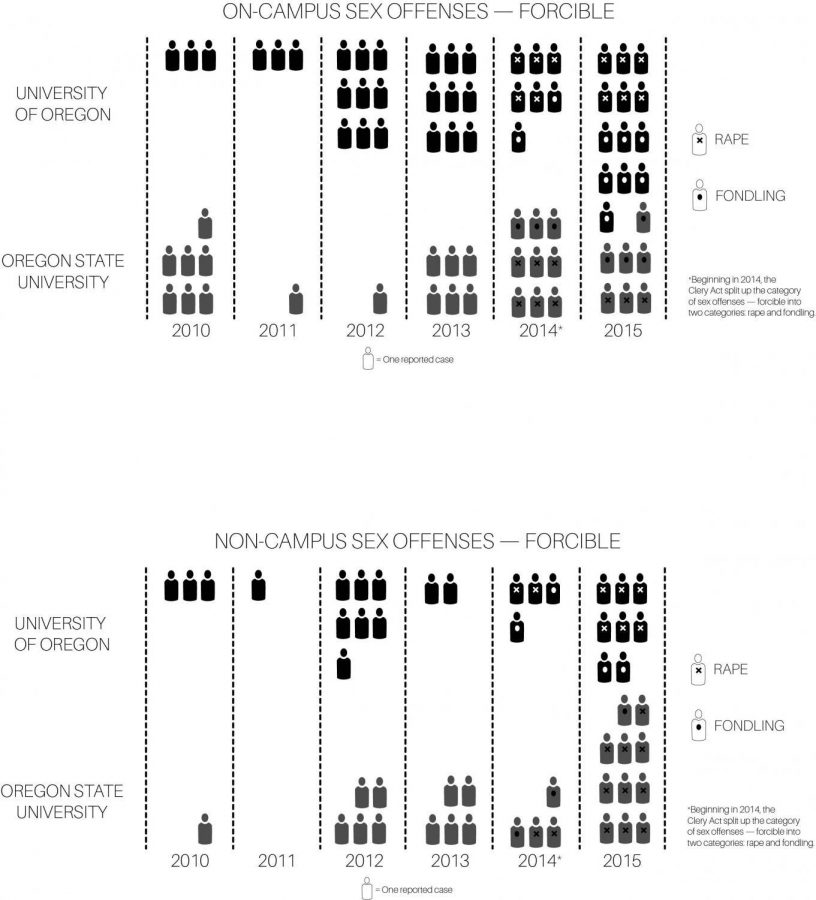Assault statistics publicly accessible
April 24, 2017
In the year 2015, there were 18 reported sexual assaults related to Oregon State University. Eleven of these occurred on property affiliated with OSU, and seven occurred on OSU’s campus.
This information is public on the U.S. Department of Education’s Campus Safety and Security website, as provided by the Jeanne Clery Disclosure of Campus Security Policy and Crime Statistics Act, otherwise known as the Clery Act. Statistics on sexual assault as well as all other crime statistics for OSU and every other college campus in the nation are reported under the Clery Act.
The Clery Act enforces transparency surrounding crime statistics and policies at college campuses, including those involving sexual assault, according to The Clery Center’s website. The Clery Act became law in 1990, inspired by the lobbying of parents who lost their daughter, Jeanne Clery, to rape and murder in her residence hall. Under the law, all colleges must contribute complete reports of campus crime to the Clery database and provide students and employees a public annual security report on October 1, in order to receive Title IX funds.
Efforts around Title IX, like those associated with the Clery Act, are working to end sexual assaults, according to OSU Vice Provost for Student Affairs Susie Brubaker-Cole.
“One of the primary goals of all the energy and resources invested in Title IX (legislation that prohibits discrimination on the basis of sex within the education system) across the country is to eliminate sexual assault on college campuses,” Brubaker-Cole said in an email. “Given the prevalence today, that goal will not be achieved overnight, so it is essential that universities track reported incidents of sexual assault over time to measure progress and ensure that our actions are indeed moving toward elimination of this violence in our communities.”
Colleges and universities have a number of responsibilities they need to understand under the Clery Act to further campus safety, according to the Clery Center website. In addition to reporting crime statistics, colleges and universities must also issue timely warnings to all students when crimes do occur.
Under the Clery Act, the crimes are categorized based on location and are reported as on-campus, on-campus student housing, non-campus and public property, according to Michele Spaulding, OSU’s Clery compliance manager. For an assault to be reported in OSU’s Clery statistics, it must occur on-campus, on public property bordering campus, such as Monroe Avenue, or on property affiliated with OSU.
“Non-campus locations include Greek houses and agricultural or other research facilities owned by the university,” Spaulding said. “Crimes that occur at off-campus locations such as at a community park, retail store, restaurant, privately owned home or apartment complex are not part of what is reported by OSU in its Clery Act crime statistics.”
OSU tracks sexual assault data in different ways, according to Spaulding.
“According to the requirements of the federal Clery Act, the university tracks four crimes in the sexual assault category: rape, fondling, incest and statutory rape,” Spaulding said.
Until 2013, the statistics for sexual assault were categorized differently. According to the Know Your IX website, the Campus Sexual Violence Elimination Act of 2013 broadened Clery requirements to include reports of all incidents of sexual violence.
“Prior to 2013, sexual assault statistics were separated by forcible and non-forcible crimes and were divided into these categories: forcible rape, forcible sodomy and forcible sexual assault with an object. After 2013, the forcible and non-forcible labels were removed,” Spaulding said.
On the Clery Report, rape and fondling are now sexual assaults classified as forcible sexual assaults while incest and statutory rape are classified as non-forcible sexual assaults.
This change in classification does not affect the accuracy of the data, according to Spaulding.
“Accuracy is still provided. However, the change in crime definitions acknowledges that a lack of consent, rather than the use of force, is key in determining if a sexual assault has occurred,” Spaulding said.
According to Judy Neighbours, the Associate Director of the OSU Survivor Advocacy and Resource Center, many survivors nationwide choose not to report. Their unreported assaults are not included in the Clery data.
“The national studies tell us that only five to 10 percent of survivors nationally report to the authorities,” Neighbours said.
According to the Rape, Abuse and Incest National Network organization’s website, survivors have a many reasons to avoid reporting. Twenty-six percent of student sexual assault survivors thought their situation was personal, 20 percent were worried about retaliation, 12 percent didn’t think it was important, 10 percent were worried about getting the perpetrator into trouble and nine percent didn’t think the police would help.
Even when a report is made, it may not be verified by OSU as a sexual assault for varying reasons, according to Neighbours.
“For example, believing a survivor is telling the truth and the standards of evidence do not always match, and that is very difficult for survivors,” Neighbours said. “Many survivors should be proud of themselves for taking an action and coming forward regardless of the result of the reporting procedures.”
For more information on the Clery Act and to see the Clery report, visit the Campus Security and Safety website run by the U.S. Department of Education.


















































































![Newspaper clipping from February 25, 1970 in the Daily Barometer showing an article written by Bob Allen, past Barometer Editor. This article was written to spotlight both the student body’s lack of participation with student government at the time in conjunction with their class representatives response. [It’s important to note ASOSU was not structured identically to today’s standards, likely having a president on behalf of each class work together as one entity as opposed to one president representing all classes.]](https://dailybaro.orangemedianetwork.com/wp-content/uploads/2025/03/Screenshot-2025-03-12-1.00.42-PM-e1741811160853.png)
























